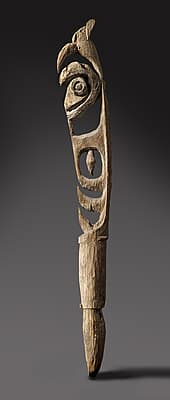
Papua New Guinea, East Sepik Province, Bogonemari River
Aripa 19th century or earlier , wood244.0 (h) x 36.0 (w) x 12.5 (d) cm National Gallery of Australia, Canberra NGA 2011.955 Purchased 2011
Aripa first came to the notice of the outside world in the early 1960s as field collectors began moving further away from the Sepik River to source more traditional art for commercial sale. Aripa are exceptionally rare and only about 200 of these figures are known to exist.
Their function is very similar to the yipwon figures - they are vessels to be inhabited by the aripa spirits who assist with hunting game. If the spirit has been correctly appeased it will track down and kill the desired prey’s spirit so it will show itself to the hunter to be killed easily. It was believed the soul (tite) of the aripa spirit being, not the artist, was responsible for the creation of their physical bodies.
The soul of the aripa and its owner are perhaps in some way connected. When a hunter died, his aripa figure’s ritual life ended and was left in a remote cave alongside his bones and personal possessions to be undisturbed for generations and preserved by the microclimate of the cave or rock shelter.
This Aripa is one of the tallest extant and follows the classic form of singular leg, opposing hook forms and large concentric eyes. The central negative space with a vertical pendant is likely to represent the aripa’s heart and lungs.
Aripa first came to the notice of the outside world in the early 1960s as field collectors began moving further away from the Sepik River to source more traditional art for commercial sale. Aripa are exceptionally rare and only about 200 of these figures are known to exist.
Their function is very similar to the yipwon figures - they are vessels to be inhabited by the aripa spirits who assist with hunting game. If the spirit has been correctly appeased it will track down and kill the desired prey’s spirit so it will show itself to the hunter to be killed easily. It was believed the soul (tite) of the aripa spirit being, not the artist, was responsible for the creation of their physical bodies.
The soul of the aripa and its owner are perhaps in some way connected. When a hunter died, his aripa figure’s ritual life ended and was left in a remote cave alongside his bones and personal possessions to be undisturbed for generations and preserved by the microclimate of the cave or rock shelter.
This Aripa is one of the tallest extant and follows the classic form of singular leg, opposing hook forms and large concentric eyes. The central negative space with a vertical pendant is likely to represent the aripa’s heart and lungs.
Aripa first came to the notice of the outside world in the early 1960s as field collectors began moving further away from the Sepik River to source more traditional art for commercial sale. Aripa are exceptionally rare and only about 200 of these figures are known to exist.
Their function is very similar to the yipwon figures - they are vessels to be inhabited by the aripa spirits who assist with hunting game. If the spirit has been correctly appeased it will track down and kill the desired prey’s spirit so it will show itself to the hunter to be killed easily. It was believed the soul (tite) of the aripa spirit being, not the artist, was responsible for the creation of their physical bodies.
The soul of the aripa and its owner are perhaps in some way connected. When a hunter died, his aripa figure’s ritual life ended and was left in a remote cave alongside his bones and personal possessions to be undisturbed for generations and preserved by the microclimate of the cave or rock shelter.
This Aripa is one of the tallest extant and follows the classic form of singular leg, opposing hook forms and large concentric eyes. The central negative space with a vertical pendant is likely to represent the aripa’s heart and lungs.
